
Tingena afflicta is a species of moth in the family Oecophoridae. It is endemic to New Zealand.
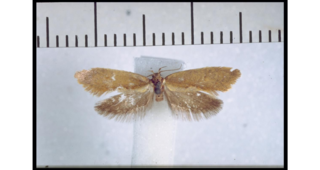
Tingena amiculata is a species of moth in the family Oecophoridae. It is endemic to New Zealand and has been observed in the Nelson, Tasman and Canterbury regions. This species has been collected amongst Hebe species and shrubland at altitudes of up to 4500 ft. It is similar in appearance to its near relatives Tingena basella and Tingena laudata.

Tingena anaema is a species of moth in the family Oecophoridae. It is endemic to New Zealand and has been collected at Lake Wakatipu, Invercargill and Stewart Island / Rakiura. The adults of the species are on the wing in December.

Tingena apanthes is a species of moth in the family Oecophoridae. It is endemic to New Zealand and found on the North Island. The adults are on the wing from October to December. It appears associated with Leptospermum species and it has been hypothesised that the appearance of the adults of this species imitates faded Leptospermum leaves.

Tingena chloritis is a species of moth in the family Oecophoridae. It is endemic to New Zealand and has been found in the South Island. Larvae of this species feed on leaf litter. The adults of this species are light flyers and are attracted to light.

Tingena crotala is a species of moth in the family Oecophoridae. It is endemic to New Zealand and is found both in the North and South Islands. This species inhabits native forest and is on the wing in November and December.
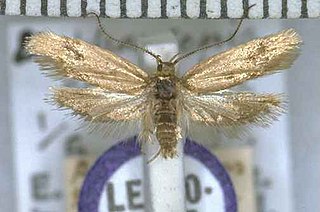
Tingena epichalca is a species of moth in the family Oecophoridae. It is endemic to New Zealand and has been observed at Arthur's Pass and in the mountains around Otira. This species is very similar in appearance to Tingena aphrontis but can be distinguished on the basis of different antennal ciliations of the male of the species. Adults are on the wing in January and inhabit alpine zones, frequenting alpine vegetation on the edge of screes at altitudes of between 3 – 4000 ft.
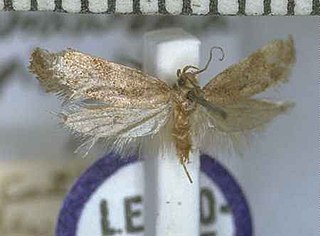
Tingena epimylia is a species of moth in the family Oecophoridae. It is endemic to New Zealand and is found in both the North and the South Islands. This species is similar in appearance to Tingena contextella as it too has a mottled appearance, but T. epimylia can be distinguished as it is smaller in size, slightly narrower wings, and has a more grey appearance and a grey head. This species inhabits native beech forests at altitudes between 1500 and 2000 ft and in particular has an affinity for Nothofagus solandri.

Tingena eriphaea is a species of moth in the family Oecophoridae. It is endemic to New Zealand and has been found in Otago. This species is known to inhabit native beech forest.
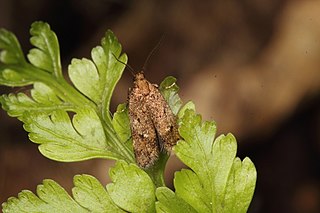
Tingena fenestrata is a species of moth in the family Oecophoridae. It is endemic to New Zealand and has been observed in the South Island. This species has been observed in native forest habitat in December.

Tingena homodoxa is a species of moth in the family Oecophoridae. It is endemic to New Zealand and is found in the southern parts of the South Island. It inhabits open grassy slopes and is on the wing from November until January.

Tingena horaea is a species of moth in the family Oecophoridae. It is endemic to New Zealand and have been observed in both the North and South Islands. The adults are on the wing in January.

Tingena idiogama is a species of moth in the family Oecophoridae. It is endemic to New Zealand and has been observed on the slopes of Mount Taranaki. Its preferred habitat is native subalpine scrub and adults are on the wing in January.

Tingena letharga is a species of moth in the family Oecophoridae. It is endemic to New Zealand and has been observed in Otago. Adults are on the wing in December and January.

Tingena melanamma is a species of moth in the family Oecophoridae. It is endemic to New Zealand and has been observed in Marlborough, Otago and Southland.

Tingena monodonta is a species of moth in the family Oecophoridae. It is endemic to New Zealand and has been found in both the North and South Islands. This species inhabits native beech forest at altitudes of between 2500 - 3000 ft. The adults of the species are on the wing from November and December.

Tingena oxyina is a species of moth in the family Oecophoridae. It is endemic to New Zealand and has been observed in the Otago region. This species inhabits native beech forest at altitudes of between 1000 - 3000 ft. Adults of this species are on the wing in January.

Tingena pharmactis is a species of moth in the family Oecophoridae. It is endemic to New Zealand and has been observed in the Nelson, Tasman and Wellington regions. The adults of this species are on the wing in December.

Tingena pronephela is a species of moth in the family Oecophoridae. It is endemic to New Zealand and is found in the southern parts of the South Island. The species inhabits the outskirts of scrub and native forest. The adults of this species are on the wing from October to February.
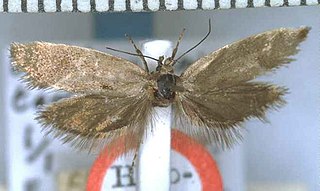
Tingena tephrophanes is a species of moth in the family Oecophoridae. It is endemic to New Zealand and has been found at Mount Arthur. Adults of this species are on the wing in January.























